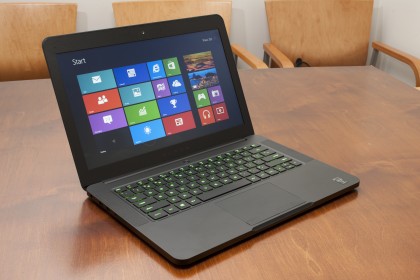TechRadar Verdict
Pros
- +
Remarkable performance
- +
Great looking laptop
- +
Comfortable, responsive keyboard
- +
High quality display
- +
High quality sound
Cons
- -
Inconsistent cursor controls
- -
Poor mouse button placement
- -
No full HD resolution
- -
Expensive
Why you can trust TechRadar
We reviewed Razer's Razer Blade Pro gaming laptop last year in September of 2012, and we found the 17-inch gaming laptop highly desirable. For the screen size, it was surprisingly thin, and it packed one heck of a performance punch.
Far and away, the feature that stood out most to us the most was the laptop's incredibly thin and light profile. We're unashamed to be MacBook fans—given Apple's superior notions of design, only the most devout Windows purist wouldn't be—but we nevertheless found ourselves hoping (praying?) that Razer might be onto something in terms of design and performance.
When you get right down to it, the 17-inch laptop just isn't for everyone—certainly not battle-hardened road warriors. But a 14-inch system with a similar emphasis on portability and performance? And boasting the same kind of emphasis on thinness and good looks as the 17-incher? Well, that's a different story.

(It's worth noting that, in conjunction with the release of the 14-inch Razer Blade, the 17-inch version slides over to become the Razer Blade Pro.)
To be honest, when Razer announced the new 14-inch Razer Blade gaming system we're reviewing here, we double-checked the specs and found ourselves wondering if this might just be the new laptop we've been dreaming of.
Our only real reservation was the screen resolution, which at 1600 x 900 offers far fewer pixels than the MacBook Pro's 2560 x 1600 Retina Display.
How big of a deal is this? And how does the Razer Blade stack up in terms of gaming performance?
Sign up for breaking news, reviews, opinion, top tech deals, and more.
The short answers are "not very" and "very well".
Let's jump into the review.
MacBook-style design, but with attitude
As a general rule, we try to avoid using the word sexy when describing devices and hardware, but the 14-inch Razer Blade is undeniably, truly sexy.
The laptop boasts the same exact design aesthetic as its bigger, older 17-inch brother. The black-matte aluminum finish and cool-looking Razer insignia on the lid make it clear that, even if this system has roughly the same profile as a MacBook Pro, it is not your typical portable computer.
Fluorescent green accents on the USB ports, the logo, and the backlit keyboard enhance the gamer vibe, but thankfully not too much. You'll get second looks from everyone from your grandmother to your friends to the guy sitting next to you on the plane with this laptop. That's more than you can say for some of the other rad-gamer designs out there today.

Part of the reason the Razer Blade is such a head turner is that it's surprisingly thin and light. Measuring just .66 inches high, 13.6 inches wide, and 9.3 inches long, it's actually thinner than the MacBook Pro. Considering the hardware packed into this thing (quad-core Intel Haswell CPU, next-gen Nvidia graphics part), this is no small feat.
Even the Razer Blade's 150 watt power adapter is smaller than most laptops' power bricks, making it an appropriate work/play/travel system.
The other reason the Blade is immediately lovable is its 14-inch, 1600 x 900 display, which emits a sharp enough image that we initially thought it was an IPS panel. It's not, but it's bright enough that you can use it in broad daylight, and boasts the kind of clarity and wide viewing angles that you normally find in IPS display.

The only downside to the display is that it does not run at a full 1080p HD resolution. The only way you'll get full HD resolutions is by connecting this laptop to a flat-screen monitor or HDTV via the HDMI cable.
We'll be honest: after spending a week testing and using the laptop as our primary rig (something we do with all the laptops that come across the review desk), the 1600 x 900 resolution bothered us a lot less than we thought it would.
Cool and quiet, even while gaming
Razer has gone out of its way to craft a thermally functional rig as well. Two small, quiet exhaust fans sit on the bottom of the chassis, and two thing rubber platforms give the fans some clearance for exhaust. During normal, non-intensive gaming operations, the laptop runs cool enough that you won't ever notice the fans or any heat. More surprisingly, even during our most rigorous gaming sessions, we still didn't hear the fans.
The Razer Blade's sound design is another nice touch. On either side of the keyboard are Dolby certified stereo speakers that sound surprisingly great.

In fact, the only real glaring weakness in the Razer Blade's design is the trackpad. Even at a glance, it will be clear to most users that the left and right buttons are insufficient for heavy duty use both working and playing.
Unfortunately, the flaws go a little deeper than this. At various moments during testing, we experienced a few different glitches, the most annoying of which was a random cursor jump that appeared to be caused by some kind of sensitivity to the palm of our left hand. Imagine editing a document and suddenly finding your cursor 3 sentences up, and you can probably feel our pain.

No matter what sensitivity adjustments we made in the Synaptics settings panel, we couldn't fully eradicate the problem. To be fair, 95% of the time we experienced a reliable, accurate touchpad experience.
Regardless, we would have greatly preferred a MacBook style clickable touchpad here. The touchpad wasn't a deal breaker for us, but it's a big source of concern, and might be for more particular users.
